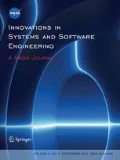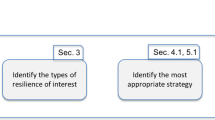Abstract
Designing autonomic fault responses is difficult, particularly in large-scale systems, as there is no single ‘perfect’ fault mitigation response to a given failure. The design of appropriate mitigation actions depend upon the goals and state of the application and environment. Strict time deadlines in real-time systems further exacerbate this problem. Any autonomic behavior in such systems must not only be functionally correct but should also conform to properties of liveness, safety and bounded time responsiveness. This paper details a real-time fault-tolerant framework, which uses a reflex and healing architecture to provide fault mitigation capabilities for large-scale real-time systems. At the heart of this architecture is a real-time reflex engine, which has a state-based failure management logic that can respond to both event- and time-based triggers. We also present a semantic domain for verifying properties of systems, which use this framework of real-time reflex engines. Lastly, a case study, which examines the details of such an approach, is presented.
Similar content being viewed by others
References
Aghasaryan A, Fabre E, Benveniste A, Boubour R, Jard C (1998) Fault detection and diagnosis in distributed systems: an approach by partially stochastic petri nets. Discrete Event Dyn Syst 8(2):203–231
Ahuja S, Bapty T, Cheung H, Haney M, Kalbarczyk Z, Khanna A, Kowalkowski J, Messie D, Mosse D, Neema S, Nordstrom S, Oh J, Sheldon P, Shetty S, Wang L, Yao D (2005) RTES demo system2004. SIGBED Rev 2(3):1–6
Alur R, Dill DL (1994) A theory of timed automata. Theor Comput Sci 126(2):183–235
Behrmann G, David A, Larsen KG (2004) A tutorial on uppaal. In: SFM, pp 200–236
Bengtsson J, Larsen K, Larsson F, Pettersson P, Yi W (1996) Uppaal a tool suite for automatic verification of real-time systems. In: Proceedings of the DIMACS/SYCON workshop on Hybrid systems III: verification and control. Springer-Verlag, New York, Inc., Secaucus, pp 232–243
Buttazzo GC (2005) Hard real-time computing systems: predictable scheduling algorithms and applications. Kluwer, Norwell
Cassandras CG, Lafortune S (1999) Introduction to discrete event systems. Kluwer, Norwell
Clarke EM, Grumberg O, Peled DA (2000) Model checking. MIT Press, Cambridge
de Kleer J, Williams BC (1987) Diagnosing multiple faults. Artif Intell 32(1):97–130
Dubey A, Nordstrom S, Keskinpala T, Neema S, Bapty T (2006) Verifying autonomic fault mitigation strategies in large scale real-time systems. In: EASE, pp 129–140
Frank PM (1990) Fault diagnosis in dynamic systems using analytical and knowledge-based redundancy a survey and some new results. Automatica 26(3):459–474
Garlan D, Cheng SW, Schmerl B (2003) Increasing system dependability through architecture-based self-repair. In: de Lemos R, Gacek C, Romanorsky A (eds) Architecting dependable systems. Springer, Berlin, pp 61–89
Gertler J (1998) Fault detection and diagnosis in engineering systems. Marcel Dekker, New York
Gutleber J et al (2001) Clustered data acquisition for the CMS experiment. In: International conference on computing in high energy and nuclear physics
Haney M, Ahuja S, Bapty T, Cheung H, Kalbarczyk Z, Khanna A, Kowalkowski J, Messie D, Mosse D, Neema S, Nordstrom S, Oh J, Sheldon P, Shetty S, Volper D, Wang L, Yao D (2005) The RTES project – btev, and beyond. In: Real time conference, 2005, 14th IEEE-NPSS, pp 143–146
Henzinger T, Nicollin X, Sifakis J, Yovine S (1994) Symbolic model checking for real time systems. Inf Comput 111(2):193–244
Huth M, Ryan M (2000) Logic in computer science: modelling and reasoning about systems, 2nd edn. Cambridge University Press, Cambridge
Krcál P, Yi W (2004) Decidable and undecidable problems in schedulability analysis using timed automata. In: TACAS, pp 236–250
Kwan S (2002) The btev pixel detector and trigger system. In: FERMILAB-Conf-02/313
Lamperti G, Zanella M (2002) Diagnosis of discrete event systems from uncertain temporal observations. Artif Intell 137(1–2):91–163
Lerner U, Parr R, Koller D, Biswas G (2000) Bayesian fault detection and diagnosis in dynamic systems. In: Proceedings of the 17th National conference on artificial intelligence and 12th conference on innovative applications of artificial intelligence. The MIT Press, Cambridge, pp 531–537
Lunze J (2000) Diagnosis of quantized systems based on a timed discrete-event model. IEEE Trans Syst Man Cybern A 30(3):322–335
Madl G, Abdelwahed S, Karsai G (2004) Automatic verification of component-based real-time corba applications. In: RTSS, pp 231–240
Nordstrom S, Bapty T, Neema S, Dubey A, Keskinpala T (2006a) A guided explorative approach for autonomic healing of model based systems. In: Second IEEE conference on space mission challenges for information technology (SMC-IT)
Nordstrom S, Dubey A, Keskinpala T, Bapty T, Neema S (2006b) Ghost: guided healing and optimization search technique for healing large-scale embedded systems. In: 3rd IEEE international workshop on engineering of autonomic and autonomous systems (EASE’06)
Nordstrom S, Shetty S, Neema SK, Bapty TA (2006) Modeling reflex-healing autonomy for large scale embedded systems. IEEE Trans Syst Man Cybern C 36(3):292–303
Parashar M, Hariri S (2004) Autonomic computing: an overview. In: UPP, pp 257–269
Patton RJ, Frank PM, Clarke RN (eds) (1989) Fault diagnosis in dynamic systems: theory and application. Prentice-Hall, Inc., Upper Saddle River
Rafea AA, Desouki AE, El-Moniem S (1990) Combined model expert system for electronics fault diagnosis. In: IEA/AIE ’90: Proceedings of the 3rd international conference on Industrial and engineering applications of artificial intelligence and expert systems. ACM Press, New York, pp 23–31.DOI http://doi.acm.org/10.1145/98784.98793
Ramadge P, Wonham W (1987) Supervisory control of a class of discrete event processes. Siam J Control Optim 25(1):206–230
Resnick M (1999) Decentralized modeling and decentralized thinking. In: Feurzeig W, Roberts N (eds) Modeling and simulation in science and mathematics education. Springer, New York, pp 114–137
Rothenberg J (1989) The nature of modeling. In: Widman LE, Loparo KA, Nielsen NR (eds) Artificial intelligence, simulation and modeling. Wiley, New York, pp 75–92
Sampath M, Sengupta R, Lafortune S, Sinnamohideen K, Teneketzis D (1996) Failure diagnosis using discrete-event models. IEEE Trans Control Syst Technol 4(2):105–124
Shetty S, Nordstrom S, Ahuja S, Yao D, Bapty T, Neema S (2005) Systems integration of large scale autonomic systems using multiple domain specific modeling languages. In: ECBS, pp 481–489
Sterritt R (2005) Autonomic computing. Innovations in Syst Softw Eng 1(1):79–88
Sterritt R, Hinchey MG (2005) Autonomic computing – panacea or poppycock? In: ECBS, pp 535–539
Truszkowski WF, Hinchey MG, Rash JL, Rouff CA (2006) Autonomous and autonomic systems: a paradigm for future space exploration missions. IEEE Trans Syst Man Cybern C 36(3):279–291
Vries RD (1990) An automated methodology for generating a fault tree. IEEE Trans Reliab 39:76–86
Yao D, Neema S, Nordstrom S, Shetty S, Ahuja S, Bapty T (2005) Specification and implementation of autonomic large-scale system behaviors using domain specific modeling language tools. In: Proceedings of international conference on software engineering and practice
Yovine S (1997) Kronos: a verification tool for real-time systems. Int J Softw Tools Technol Transfer 126:110–122
Author information
Authors and Affiliations
Corresponding author
Rights and permissions
About this article
Cite this article
Dubey, A., Nordstrom, S., Keskinpala, T. et al. Towards a verifiable real-time, autonomic, fault mitigation framework for large scale real-time systems. Innovations Syst Softw Eng 3, 33–52 (2007). https://doi.org/10.1007/s11334-006-0015-7
Received:
Accepted:
Published:
Issue Date:
DOI: https://doi.org/10.1007/s11334-006-0015-7




